Hill People Gear is known for its extensive selection of high-quality chest packs. These things are immensely popular among members of my SAR team and for a long time I haven’t really seen the need for one. After completing the SAR training I attended a few weeks back I realized their utility and ordered a Hill People Gear SAR Kit Bag, Medium.
This article contains affiliate links.
Full Disclosure: I paid full price for my Hill People Gear SAR Kit Bag, Medium. This review was not coordinated in any way with Hill People Gear, and I receive no incentives, financial or otherwise for this review or the sales of HPG merchandise.
Why A Chest Rig?
If you’re like me you’re probably wondering why this thing is necessary. There are three main reasons for a chest pack (which HPG calls a “kit bag”). They are convenience, survival, and minimalism. Let’s look at all three.
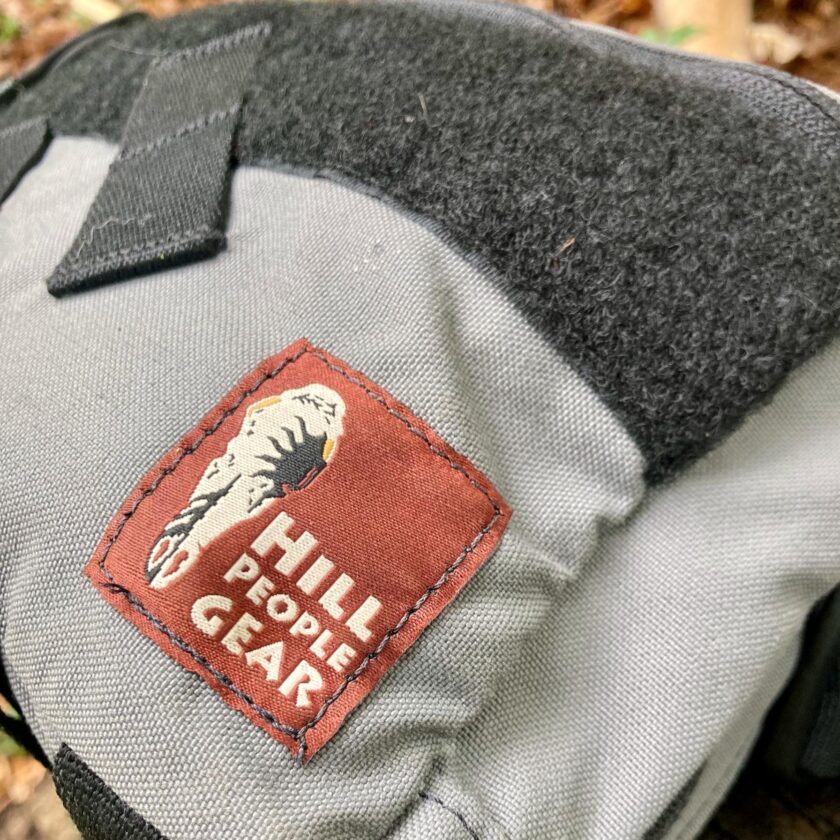
Convenience is a huge reason for wearing a chest rig. The SAR class I attended had a large land navigation component. Every time I arrived at a point I had to navigate to the next point. Since all my map stuff was in my pack I had to drop my pack, dig it all out, then pack it all back up, and put my pack back on. Everyone with a chest rig had this stuff immediately available. I was definitely jealous during that portion of the training.
Survival is another reason for a small chest rig. It lets you wear a small pack containing some critical survival items and keep it on your body. If you have to get on rope, use the bathroom, do a little scouting, or whatever, you may drop your pack. You don’t have to drop your chest rig, though. This is also a great option for guys like me who, as part of my day job duties, may have to go in the woods with a paramedic jump bag. This lets me carry the jump bag and some personal survival gear. I’ll talk about the survival stuff I keep in mine a little further down.
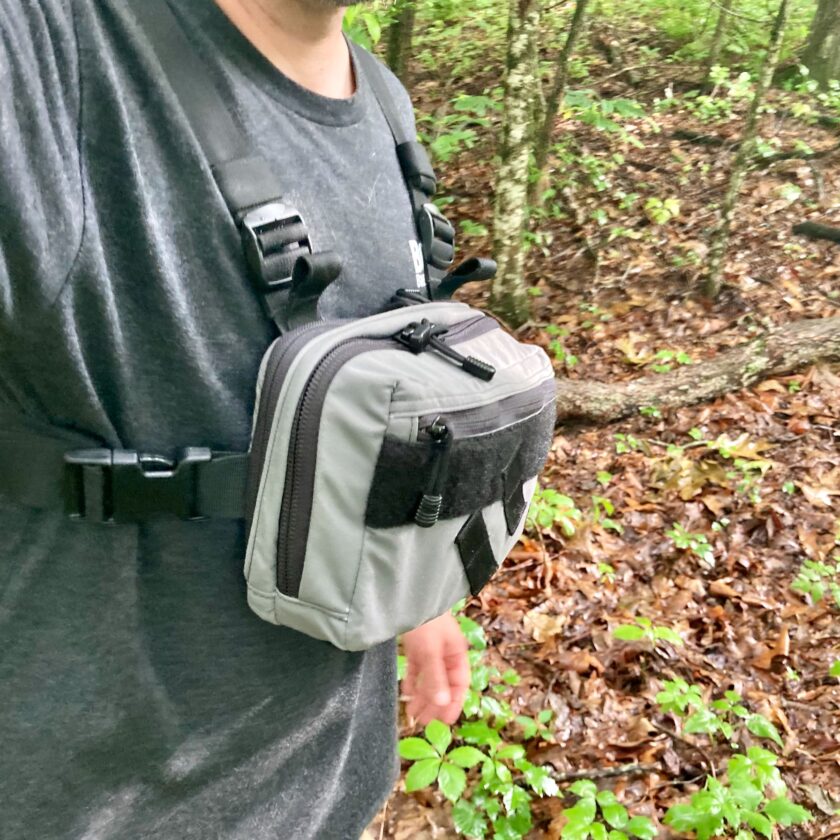
Minimalism is the third reason I can think of to have a chest rig. Not every hike or SAR call-out requires a full rucksack. Sometimes throwing on a minimalist kit and going with it is perfectly acceptable. Having a chest rig gives you flexibility in letting you choose what you carry and what you don’t.
With the reason for these packs laid out, let’s take a look at the pack itself.
Hill People Gear SAR Kit Bag, Medium
Hill People Gear makes a variety of kit bags. I will do my best to break them down.
Models & Sizes
There are three main models: the Recon, the SAR, and the Original. The differences between the three are in the MOLLE webbing across the front. The Original has none, the SAR has MOLLE straps for a radio pouch, and the Recon has MOLLE from head-to-toe across the front panel. There is also a very minimalist Runner’s model that is intended mainly just to carry a handgun.
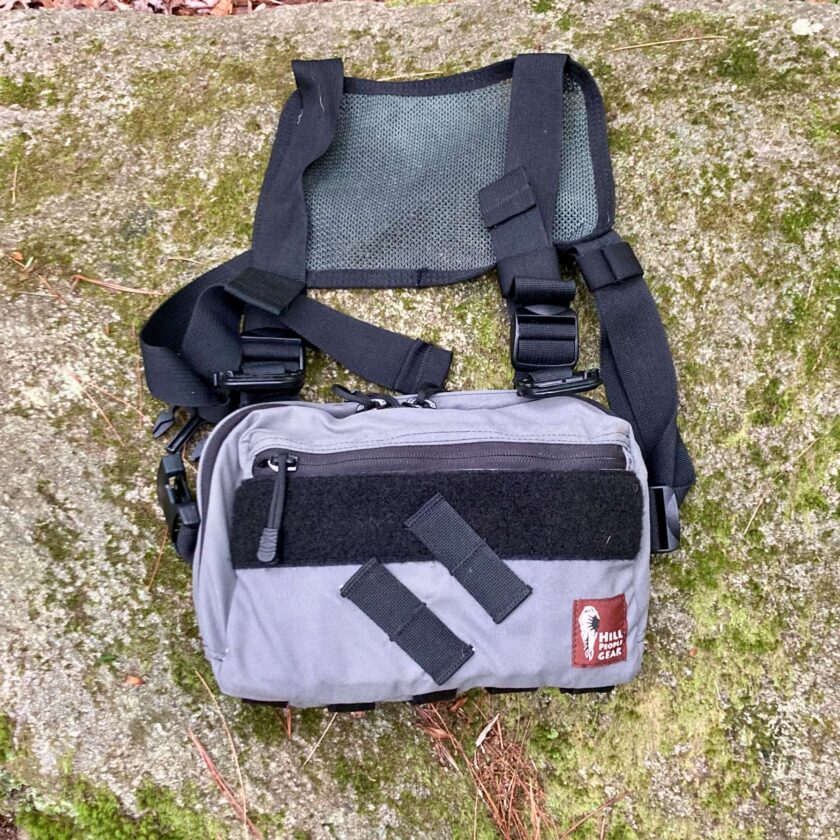
And then there are sizes. All three models come in (from largest to smallest): Heavy, Full, Medium, and Snubby. These roughly translate to XL, L, M, and S, respectively. Due to the variety of bag/size combinations, you’ll want to do some research on HPG’s website before committing to one. Once you pick your bag, though, I think you’ll be happy with it.
I chose the SAR Kit Bag, Medium for a few reasons. First, I didn’t want MOLLE webbing all over the front of the pack. However, I may put a radio pouch on there at some point. I chose the medium model because of my frame – I’m not a huge guy. I wanted to keep the back within the margins of my chest so it wouldn’t interfere with my pack straps. So far it has worked out really, really well.
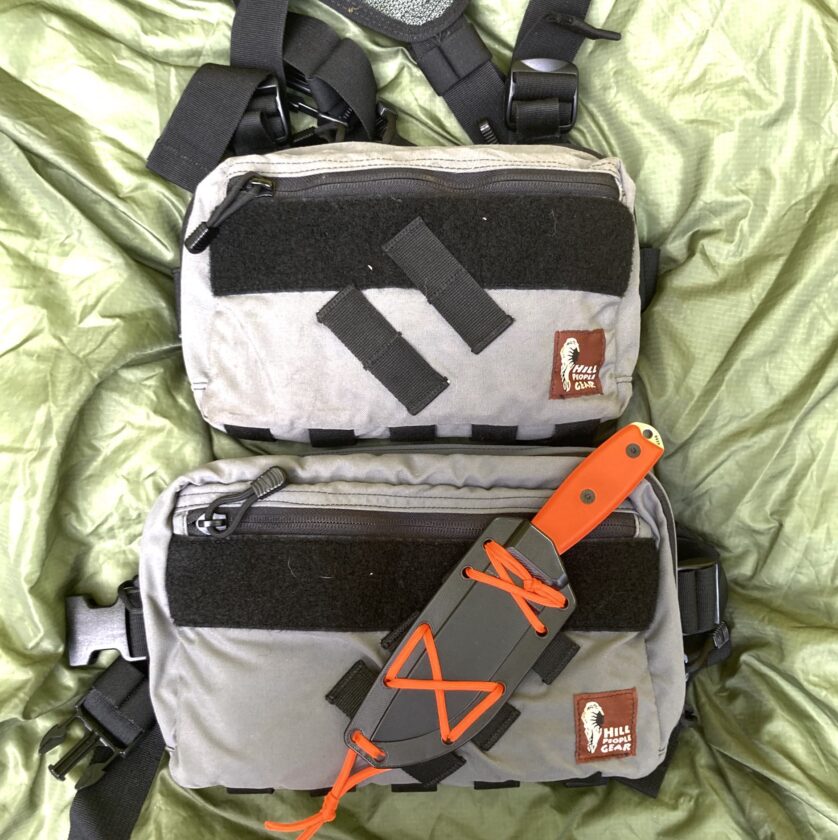
HPG Kit Bags are also available in a broad range of colors from bright red to Multi-Cam. Other colors include black, blue, coyote, and blaze orange. I chose the grey (technically “Manatee/Black”) because it was dull without looking tactical. Let’s take a quick look at the pack’s construction
Construction
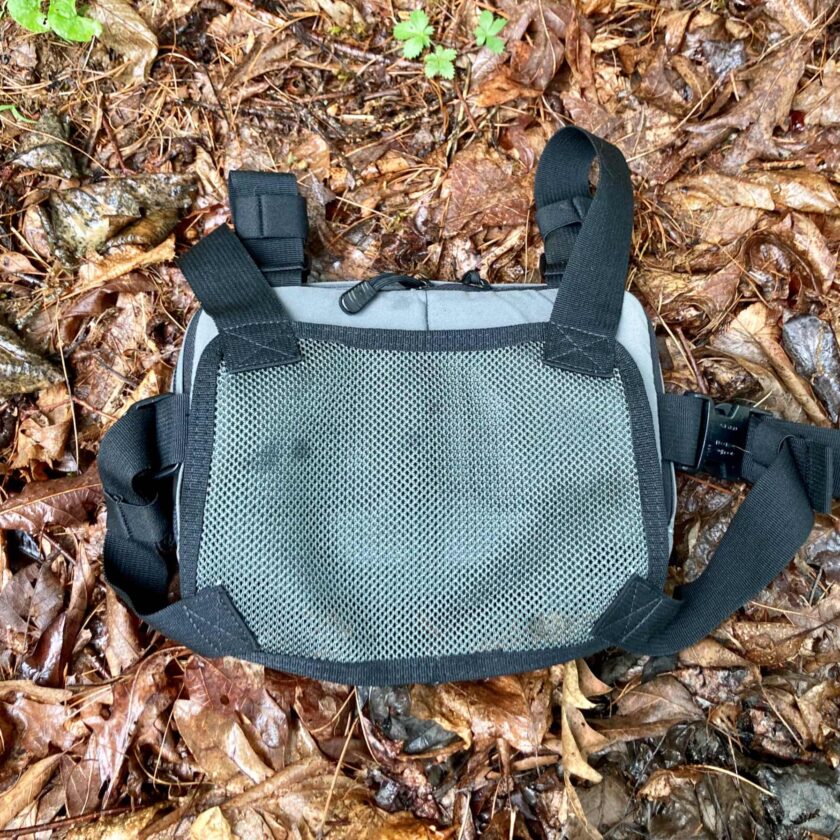
The pack is exceedingly well-built. Materials are top-notch and the stitching is precise and strong. The pack is made of 500D nylon The harness consists of a strap over each shoulder, one around the body, with a mesh back panel. One side of the around-the-body panel unsnaps for donning and doffing the rig. Straps are easily adjustable and come with elastic keepers for wrangling the excess.
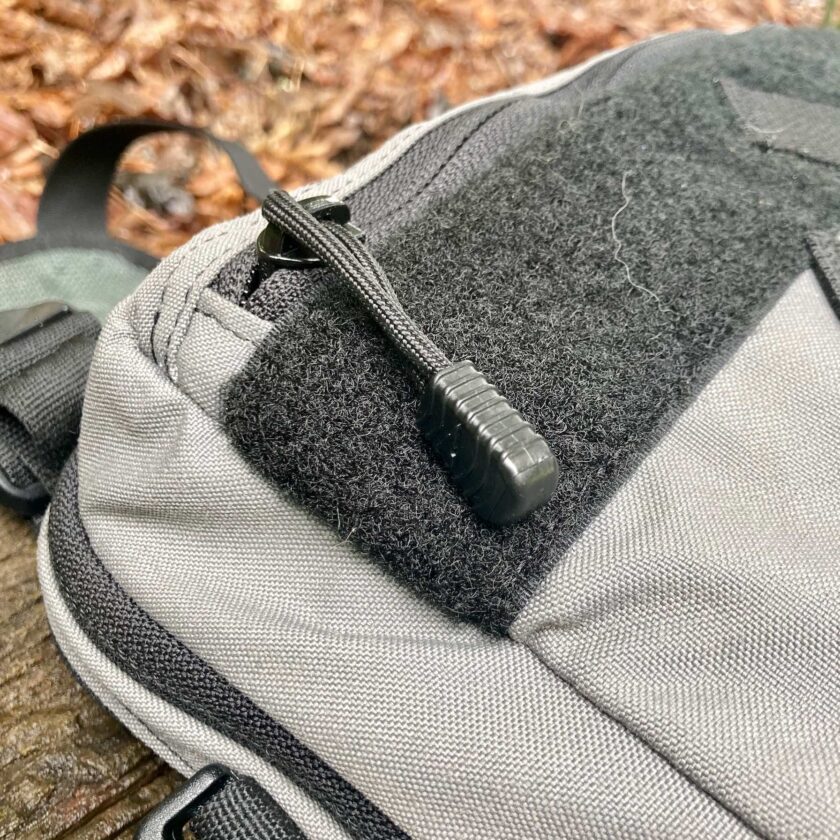
As you have probably noticed by now there is a large, pile-portion strip of Velcro across the front of the bag. I do wear a simple name tape on here during SAR operations. Honestly this is mostly so my bag isn’t mistaken for someone else’s if I set it down at a staging area. This strip will hold any number of identifiers, morale patches, etc.
Pockets
The SAR Kit Bag has three pockets. The first, on the front, is flat. It can quickly get consumed by filling the main center pocket. I use it for mapping stuff which is mostly flat, and my compass which I generally remove and place around my neck during a SAR search. There are two organizer flaps within the front pocket.
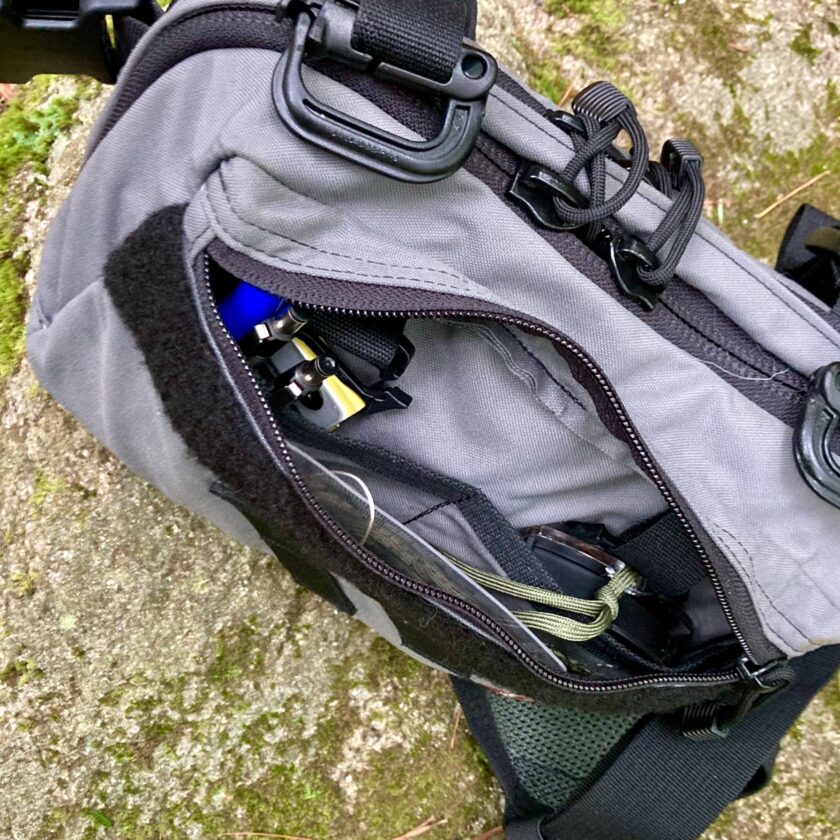
The center pocket is the main storage on the SAR Kit Bag. It opens on three sides and folds down. The back panel of this pocket is MOLLE compatible for use with admin pouches, organizers, or perhaps holsters. Since a pouch or pocket would take up more space within the bag I don’t use one. The front panel has two organizer flaps, and two loops that can be used to dummy-cord critical items.
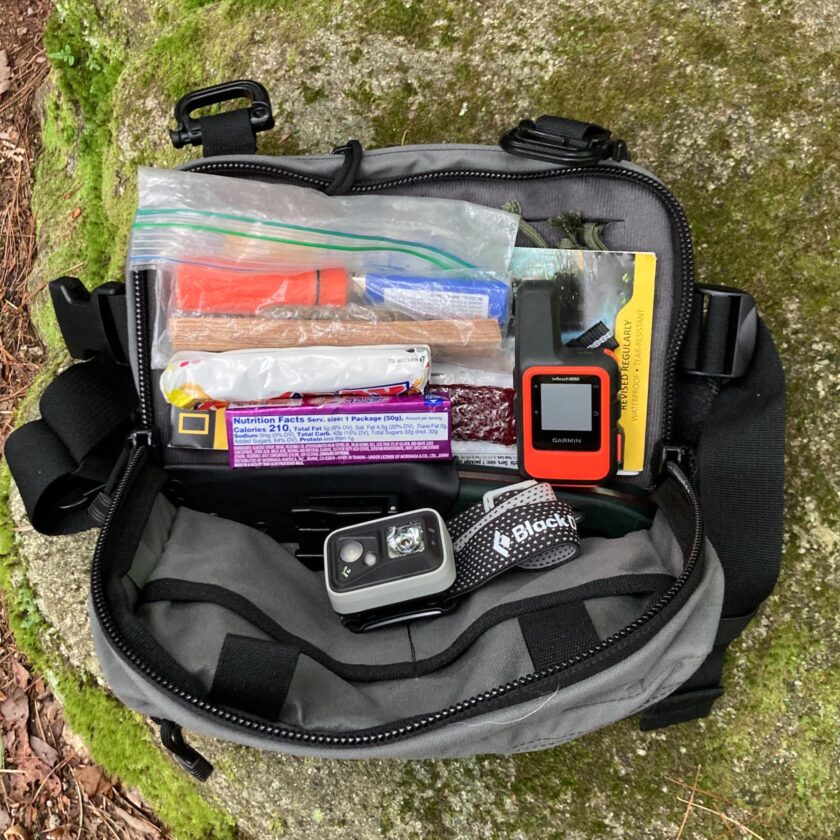
There is also a flat pocket on the back. Unlike the front pocket this one is discrete, and does not get consumed by a full center pocket. The intended purpose of this pouch is for the carry of a handgun and has a strip of Velcro for mounting a holster. Since I prefer to carry my handgun on my belt I have reserved this pocket for a couple flat survival items, but more on that in a minute.
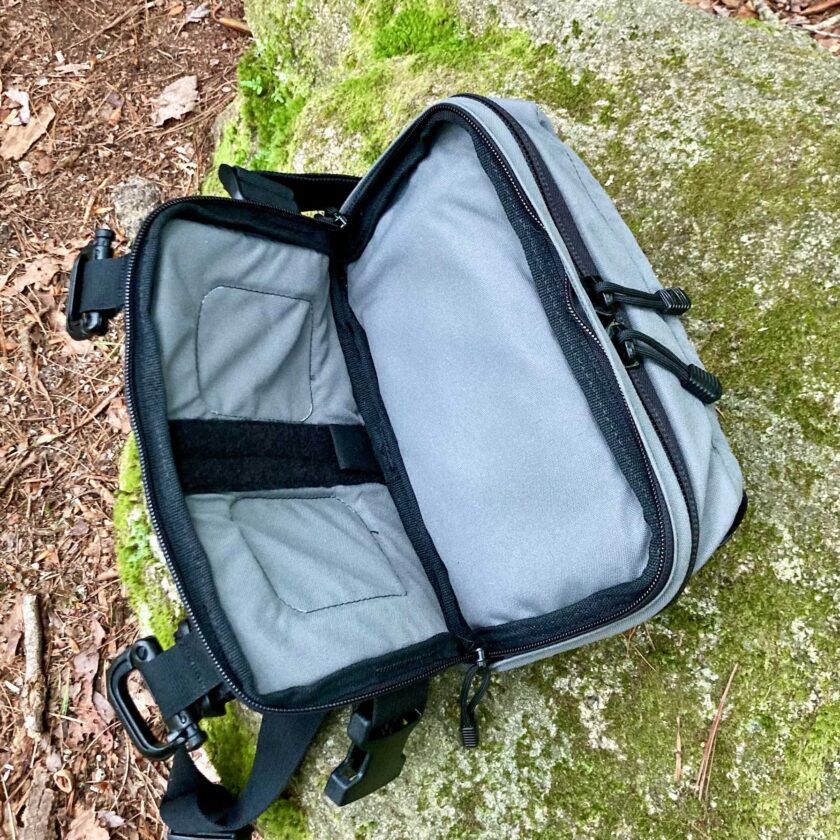
That is the basic run-down of the rig. Let’s talk about carrying/wearing it, and what I put in it.
Wearing the SAR Kit Bag
I have worn this chest rig for about 25 miles of backcountry hiking so far. All of it has been in tandem with my Mystery Ranch Scree 32 backpack. I have mostly worn it on personal hikes, but I have also worn it on two searches so far (one of which involved a brutal 1,550′ ascent in under 1 KM). For both of the SAR ops I was a team leader and was super thankful for the convenience of quick access to maps, notes, etc. So far I really like it. It is comfortable, keeps my survival essentials on my body, and gives quick, convenient access to frequently-accessed stuff like map, compass, and notepad.
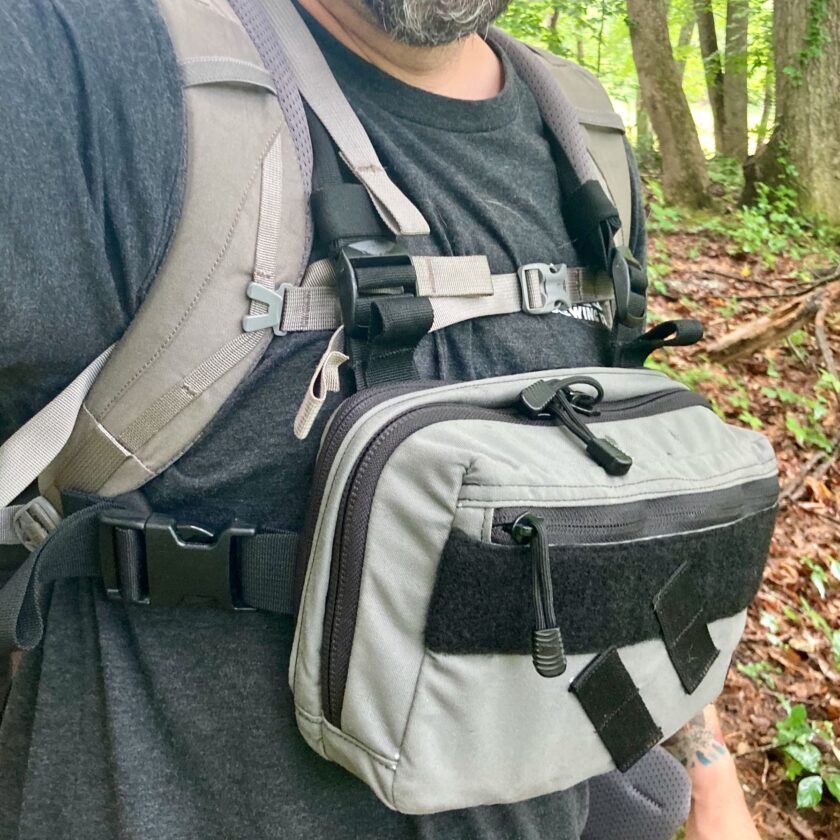
My biggest worry was that this pack would not be comfortable under a backpack. This concern proved to be a non-issue, however. I barely notice the SAR Kit bag. Initially I had some problems when I tried to buckle my sternum strap over the SAR Kit Bag’s harness. This pressed the buckles into my chest and was quite irritating. Fixing this minor issue only required routing my sternum strap under the kit bag’s harness. Though I haven’t attempted it yet, I expect this bag to be insanely comfortable when coupled with a lumbar pack like my Mountainsmith Tour.
One complaint I do have is heat. The placement of the SAR Kit Bag over one’s chest makes it hot. It covers that much more body surface area and holds in that much more heat. Even in mild weather my shirt is normally soaking wet under the SAR Kit Bag. On the other hand this is definitely no worse that when wearing a military chest rig, which generally covers much more of the body. It’s definitely bearable, though.
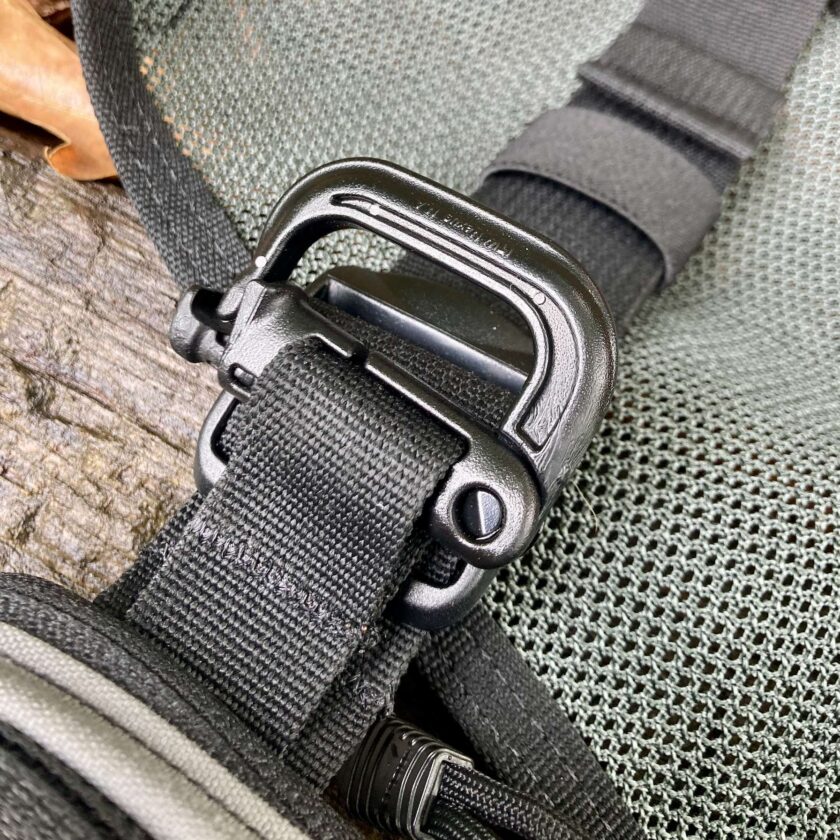
The SAR Kit Bag also comes with two additional straps for attaching it to a backpack, attached by large “Grimloc” plastic D-rings. To be honest I found these to be in the way and got rid of them. Also, I wish these were optional and the bag was about $10 cheaper for not getting them. This is a “feature” I never see myself using. Getting rid of them makes the bag a little lighter and more streamlined.
My Contents
Let’s talk about the contents of my Hill People Gear SAR Kit Bag. It’s an odd mix of survival and administrative equipment. The survival equipment meets Dave Canterbury’s “5 Cs of Survivability“: Cutting (knife), Combustion, Container, Cover, and Cordage. We will go pocket-by-pocket, and work front to back.
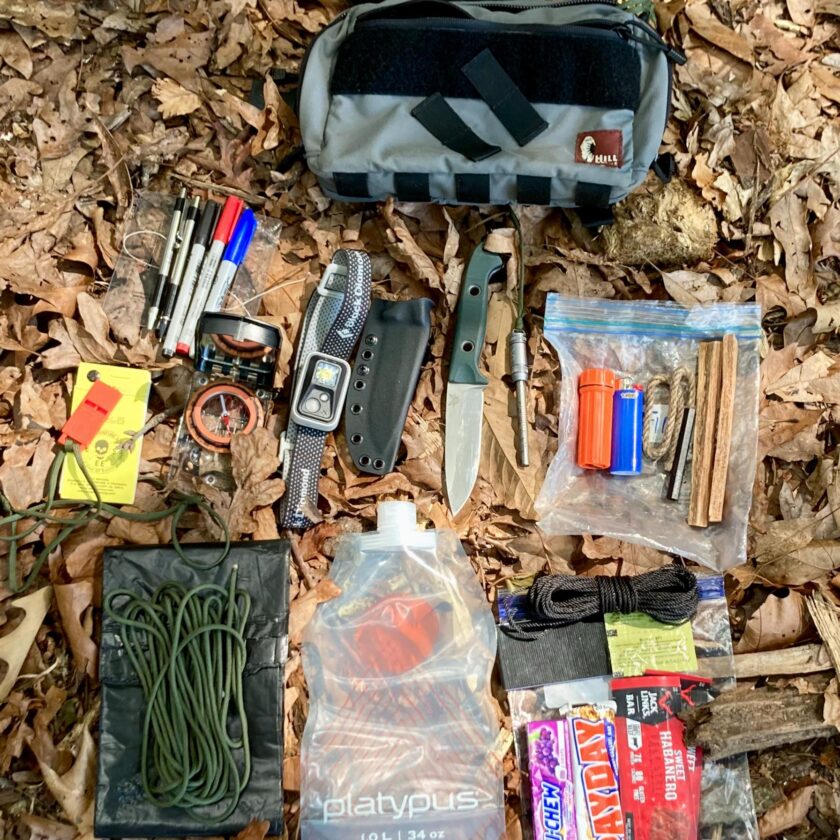
Front Pocket
This pocket contains mostly administrative stuff. It contains a small notepad and several writing implements. The are a pen, a mechanical pencil, a blue Sharpie, and two alcohol-erasable map pens. I also use a military-style protractor for plotting coordinates on a map. During the SAR class I took in may these became the envy of every student because we did a lot of map work.
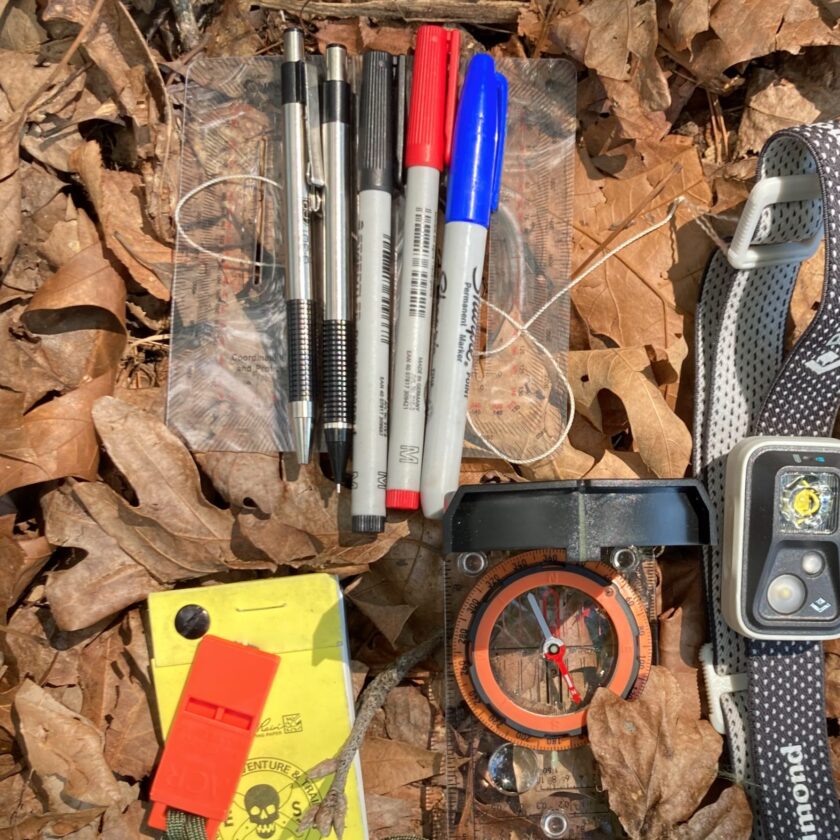
Finally, I carry my compass and a whistle, both secured to a 550-cord lanyard. During a search these come out of the bag and go around my neck for easy access. I can check my azimuth at will, and I use the whistle instead of shouting the lost person’s name. The compass is a Silva Ranger 2.0 and the whistle is an ACR “Res-Q” whistle.
Center Pocket
This is the main pocket and where I keep most of my stuff. First, I keep a fire kit. This kit contains two pieces of fatwood, and a match case filled with Vaseline-coated cotton balls. With these two forms of tinder I can start a fire in almost any condition. For ignition sources I have a Bic lighter and a Exotac Firerod (a ferrocerium rod), which is dummy-corded directly to the pack. This gives me an easy, flame-producing method and a more durable sparking method of ignition. I also have an überleben Tindar Wick to assist with lighting fires. You can light the hemp cord and use it as a match. All of this is stored in a 1-quart Ziploc bag.
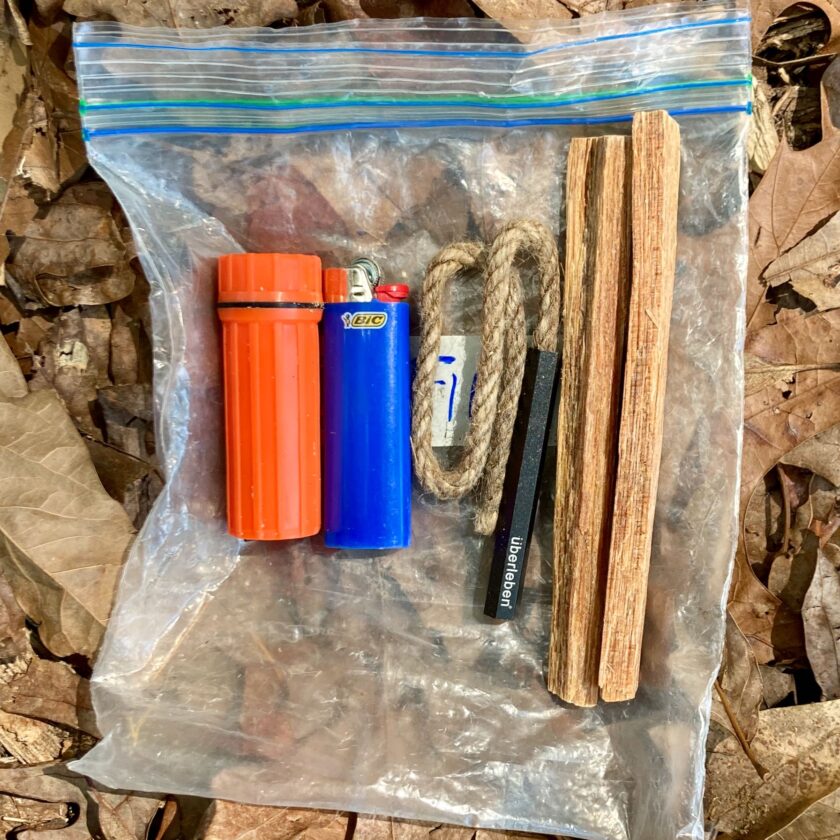
Another Ziploc contains some food and some miscellaneous supplies. The food is a Payday bar, a couple jerky sticks, and some candy (usually Hi-Chew). Though it wouldn’t be fun this would get me through a day or two in the woods. I also have four water purification tablets, some tarred bank line, and 10′ of Gorilla tape wrapped around a business card.
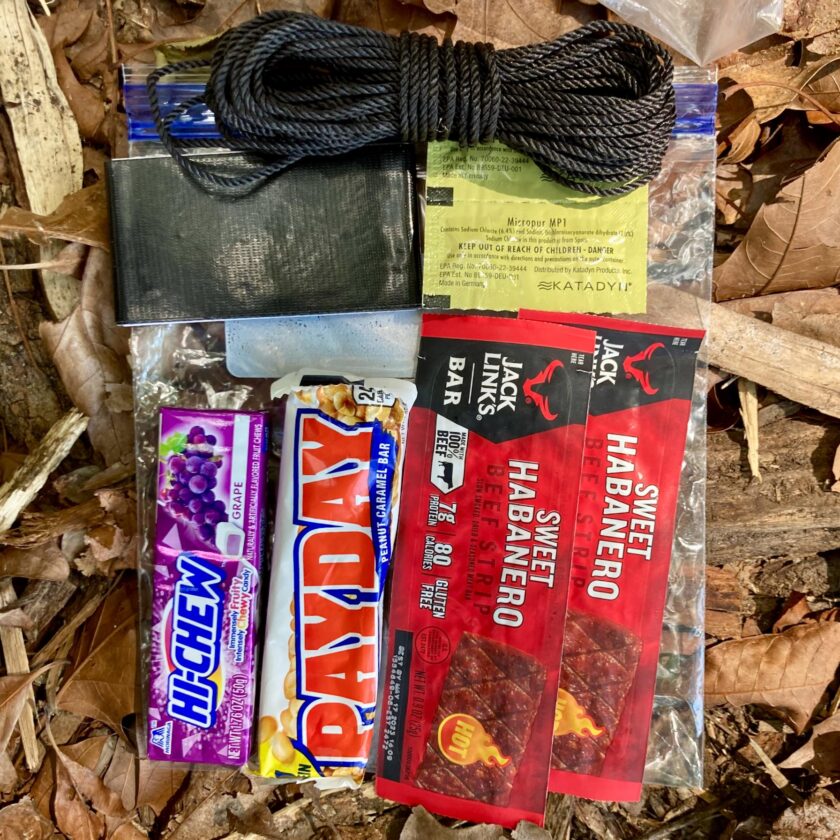
Then there are a couple loose items. A 1-liter Platypus water bladder gives me a way to store and purify water. I also have a Black Diamond headlamp. This gives me a source of light. Around camp this generally just lives around my neck and – obviously – on a night search it gets used. One of the photos above shows a GPS, but this generally lives in my pack as a backup navigation device.
Back Pocket
The pocket on the back holds a couple fairly important items. The most important is my knife, a Benchmade 162 Bushcrafter. I have done quite a bit of work with this knife since buying it about two years ago and would recommend it in a heartbeat. The sheath…not so much. The sheath shown here is a custom sheath from RK Custom. Honestly, though, the flatter (and way cheaper) ESEE-4 would be just as good a knife and bit better inside this pack.
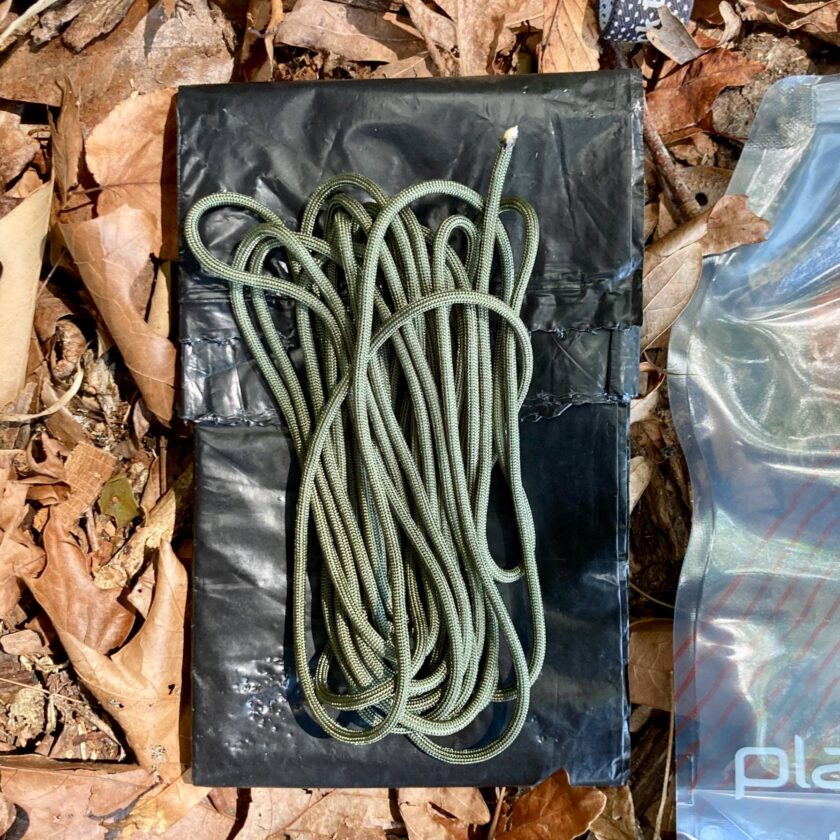
The other two items are a contractor trash bag and some 550 cord. The trash bag, when cut open makes an excellent sheet of waterproof material. Though I already have tarred bank line in the main pocket, I also have some 550 cord in the rear pocket. Cordage is worth its weight in gold in the wilderness.
Closing Thoughts
I have been a member of my local SAR team for a couple years. I have resisted the “chest rig” bandwagon for a long time. I’m finally, fully on board, though, after attending the qualifying Search & Rescue class and needing constant access to my gear. Now that I have one and have worn it a few miles I’m pretty damn satisfied with it.
If you’re looking for a convenient way to carry quick access gear, a minimalist pack, or a way to keep survival gear always on your body, check out Hill People Gear’s kit bags. I’ve been very happy with the Hill People Gear SAR Kit Bag, but as I mentioned there is a broad selection to meet just about any need. Most can be had for under $150. They are durable, comfortable, and extremely high quality.





